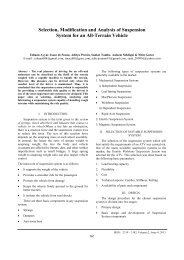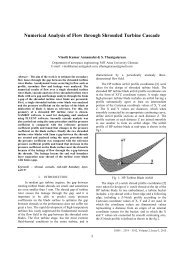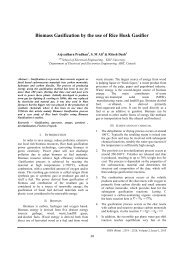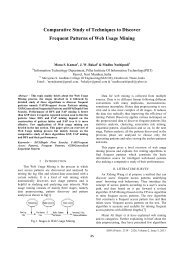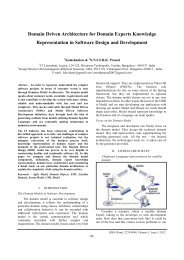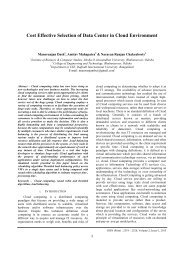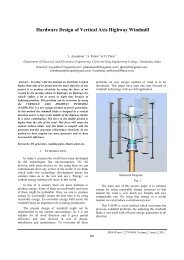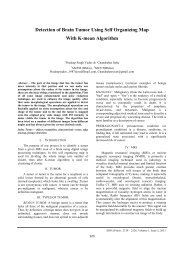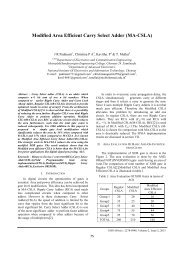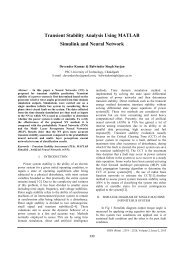Optical Orthogonal Frequency Division Multiplexing ... - IRD India
Optical Orthogonal Frequency Division Multiplexing ... - IRD India
Optical Orthogonal Frequency Division Multiplexing ... - IRD India
- No tags were found...
You also want an ePaper? Increase the reach of your titles
YUMPU automatically turns print PDFs into web optimized ePapers that Google loves.
International Journal of Advanced Electrical and Electronics Engineering, (IJAEEE)modulation format is its rich variation and ease ofadaption to a wide range of applications. In wirelesssystems, OFDM has been incorporated in wireless LAN(IEEE 802. 11a/g, or better known as WiFi), wirelessWAN (IEEE 802.16e, or better known as WiMax), anddigital radio/video systems (DAB/DVB) adopted inmost parts of the world. In RF cable systems, OFDMhas been incorporated in ADSL and VDSL broadbandaccess through telephone copper wiring or power line.This rich variation has something to do with the intrinsicadvantages of OFDM modulation including dispersionrobustness, ease of dynamic channel estimation andmitigation, high spectral efficiency and capability ofdynamic bit and power loading. Recent progress inoptical OFDM is of no exception. We have witnessedmany novel proposals and demonstrations of opticalOFDM systems from different areas of the applicationsthat aim to benefit from the afore mentioned OFDMadvantages. Despite the fact that OFDM has beenextensively studied in the RF domain, it is rathersurprising that the first report on optical OFD Min theopen literature only appeared in 1998 by Pan et al. [9],where they presented in-depth performance analysis ofhybrid AM/OFDM subcarrier-multiplexed (SCM) fiberoptic systems. The lack of interest in optical OFDM inthe past is largely due to the fact the silicon signalprocessing power had not reached the point, wheresophisticated OFDM signal processing can beperformed in a CMOS integrated circuit. <strong>Optical</strong> OFDMare mainly classified into two main categories: coherentdetection and direct detection according to theirunderlying techniques and applications. While directdetection has been the mainstay for opticalcommunications over the last two decades, the recentprogress in forward-looking research has unmistakablypointed to the trend that the future of opticalcommunications is the coherent detection. DDO-OFDMhas much more variants than the coherent counterpart.This mainly stems from the broader range ofapplications for direct-detection OFDM due to its lowercost. For instance, the first report of the DDO-OFDM[9] takes advantage of that the OFDM signal is moreimmune to the impulse clipping noise in the CATVnetwork. Other example is the single-side-band (SSB)-OFDM, which hasbeen recently proposed by Lowery etal. and Djordjevic et al. for long-haul transmission[10,11].Coherent <strong>Optical</strong> OFDM Systems:Coherent optical communication was onceintensively studied in late 1980s and early 1990s due toits high sensitivity [12–13]. However, with the inventionof Erbium-doped fiber amplifiers (EDFAs), coherentoptical communication has literally abandoned since theearly of 1990s. Pre amplified receivers using EDFA canachieve sensitivity within a few decibels of coherentreceivers, thus making coherent detection less attractive,considering its enormous complexity. In the earlytwenty first century, the impressive record-performanceexperimental demonstration using a differential-phaseshift-keying(DPSK) system [14], in spite of anincoherent form of modulation by itself, reignited theinterest in coherent communications. The second waveof research on coherent communications is highlightedby the remarkable theoretical and experimentaldemonstrations from various groups around the world[14,15, 16]. It is rather instructive to point out that thecircumstances and the underlying technologies for thecurrent drive for coherent communications are entirelydifferent from those of a decade ago, thanks to the rapidtechnological advancement within the past decade invarious fields. First, current coherent detection systemsare heavily entrenched in silicon-based DSP for highspeedsignal phase estimation and channel equalization.Second, multicarrier technology, which has emergedand thrived in the RF domain during the past decade,has gradually encroached into the optical domain [17,18]. Third, in contrast to the optical system that wasdominated by a low-speed, point-to-point, and singlechannelsystem a decade ago, modern opticalcommunication systems have advanced to massivewave-division-multiplexed (WDM) and reconfigurableoptical networks with a transmission speedapproaching100Gb s_1. In a nutshell, the primary aim ofcoherent communications has shifted toward supportingthese high-speed dynamic networks by simplifying thenetwork installation, monitoring and maintenance.When the modulation technique of OFDM combineswith coherent detection, the benefits brought by thesetwo powerful techniques are multifold [19]: (1)Highspectral efficiency; (2) Robust to chromatic dispersionand polarization-mode dispersion; (3) High receiversensitivity; (4) Dispersion CompensationModules(DCM)-free operation; (5) Less DSPcomplexity; (6) Less oversampling factor; (7) Moreflexibility in spectral shaping and matched filtering.Principle for CO-OFDM:Figure 1 shows the conceptual diagram of a typicalcoherent optical system set up. It contains five basicfunctional blocks: RF OFDM signal transmitter, RF tooptical (RTO) up-converter, Fiber links, the optical toRF (OTR) down-converter, and the RF OFDM receiver.Such setup can be also used for single-carrier scheme, inwhich the DSP part in the transmitter and receiver needsto be modified, while all the hardware setup remains thesame. We will trace the signal flow end-to-end andillustrate each signal processing block. In the RF OFDMtransmitter, the payload data is first split into multipleparallel branches. This is so-called “serial-to-parallel”60ISSN (Print) : 2278-8948, Volume-2, Issue-4, 2013
International Journal of Advanced Electrical and Electronics Engineering, (IJAEEE)local oscillator and direct detection rather than coherentdetection is used. A variety of optical OFDM solutionshave been proposed for different applications. Tounderstand these different techniques, it is useful torealize what is fundamental in each domain. For anOFDM system to work successfully the system must be(approximately) linear between the transmitter IFFTinput and the receiver FFT output. In other words, whereis either a constant or is slowly varying so that it can betracked at that the receiver. In the optical domain,optical receivers use square-law detectors. <strong>Optical</strong>OFDM solutions can be broadly divided into twogroups. The first group comprises techniques forsystems where many different optical modes arereceived, for example, optical wireless, multimode fibersystems and plastic optical fiber systems. For these theOFDM signal should be represented by the intensity ofthe optical signal. The second group includes techniquesfor single mode fiber, where only one mode of the signalis received and for these the OFDM signal should berepresented by the optical field.between neighboring OFDM symbols, formally, the socalledinter-symbol-interference (ISI). Furthermore,because the OFDM waveform in the DFT window for“slow subcarrier” is incomplete, the criticalorthogonality condition for the subcarriers is lost,resulting in an intercarrier-interference (ICI) penalty.Cyclic prefix was proposed to resolve the channeldispersion-induced ISI and ICI [23]. Figure 2(c) showsinsertion of a cyclic prefix by cyclic extension of theOFDM waveform into the guard interval. As shown inFig. 2.7c, the waveform in the guard interval isessentially an identical copy of that in the DFT window,with time-shifted by “ts” forward. Figure 2(d) shows theOFDM signal with the guard interval upon reception.Let us assume that the signal has traversed the samedispersive channel, and the same DFT window isselected containing a complete OFDM symbol for the“fast subcarrier” waveform. It can be seen from Fig.2.7d,COMPARISON OF TYPICAL OFDM SYSTEM ANDTYPICAL OPTICAL SYSTEMIV. CYCLIC PREFIX FOR OFDMIn addition to modulation and demodulation ofmany orthogonal subcarriers via (I) FFT, one has tomitigate dispersive channel effects such as chromaticand polarization mode dispersions for goodperformance. In this respect, one of the enablingtechniques for OFDM is the insertion of cyclic prefix[23, 24]. Let us first consider two consecutive OFDMsymbols that undergo a dispersive channel with a delayspread of td. For simplicity, each OFDM symbolincludes only two subcarriers with the fast delay andslow delay spread at td , represented by “fast subcarrier”and “slow subcarrier,” respectively. Figure 2(a) showsthat inside each OFDM symbol, the two subcarriers,“fast subcarrier” and “slow subcarrier” are aligneduponthe transmission. Figure 2(b) shows the sameOFDM signals upon the reception, where the “slowsubcarrier” is delayed by td against the “fast subcarrier.”We select a DFT window containing a complete OFDMsymbol for the “fast subcarrier.”It is apparent that due tothe channel dispersion, the “slow subcarrier” hascrossed the symbol boundary leading to the interferenceFig. 2: The OFDM signals (a) without cyclic prefix at thetransmitter, (b) without cyclicprefix at the receiver, (c) withcyclic prefix at the transmitter, and (d) with cyclic prefix at thereceiver.A complete OFDM symbol for “slow subcarrier” isalso maintained in the DFT window, because aproportion of the cyclic prefix has moved into the DFTwindow to replace the identical part that has shifted out.As such, the OFDM symbol for “slow subcarrier” is an62ISSN (Print) : 2278-8948, Volume-2, Issue-4, 2013
International Journal of Advanced Electrical and Electronics Engineering, (IJAEEE)“almost” identical copy of the transmitted waveformwith an additional phase shift. This phase shift is dealtwith through channel estimation and will besubsequently removed for symbol decision. Theimportant condition for ISI-free OFDM transmission isgiven by:It can be seen that after insertion of the guard intervalgreater than the delay spread, two critical proceduresmust be carried out to recover the OFDM informationsymbol properly, namely, (1) selection of an appropriateDFT window, called DFT window synchronization, and(2) estimation of the phase shift for each subcarriercalled channel estimation or subcarrier recovery. Bothsignal processing procedures are actively pursuedresearch topics, and their references can be found inboth books and journal papers [23,24].Thecorresponding time-domain OFDM symbol is illustratedin Fig. 3, which shows one complete OFDM symbolcomposed of observation period and cyclic prefix. Thewaveform within the observation period will be used torecover the frequency-domain information symbols.ideally linear regardless of its input signal power due toits slow response time in the order of millisecond.Nevertheless, the PAPR still poses a challenge foroptical fiber communications due to the nonlinearity inthe optical fiber [25–26].The origin of high PAPR of anOFDM signal can be easily understood from itsmulticarrier nature. Because cyclic prefix is an advancedtime-shifted copy of apart of the OFDM signal in theobservation period (see Fig. 2.8), we focus on the waveform inside the observation period. The transmittedtime-domain wave form for one OFDM symbol can bewritten asfkN scS(t) = ∑ c k e j2πfkt,K=1The PAPR of the OFDM signal is defined asPAPR= Max {s(t)} 2E{s(t)} 2For the simplicity, we assume that an M-PSK encodingis used, where jckj D 1. The theoretical maximum ofPAPR is 10 log10 .Nsc/ in dB, by setting ck D 1 and t D0in (2.14). For OFDM systems with 256 subcarriers, thetheoretical maxim PAPR isFig. 3: Time-domain OFDM signal for one complete OFDM symbol.V. PEAK-TO-AVERAGE POWER RATIO FOROFDMHigh peak-to-average-power ratio (PAPR) has beencited as one of the drawback sof OFDM modulationformat. In the RF systems, the major problem resides inthe power amplifiers at the transmitter end, where theamplifier gain will saturate at high input power. One ofthe ways to avoid the relatively “peaky” OFDM signal isto operate the power amplifier at the so-called heavy“back-off” regime, where the signal power is muchlower than the amplifier saturation power.Unfortunately, this requires an excess large saturationpower for the power amplifier, which inevitably leads tolow power efficiency. In the optical systems,interestingly enough, the optical power amplifier(predominately an Erbium-doped-amplifier today) isFig. 4: Complementary cumulative distribution function(CCDF), Pc for the PAPR of OFDM signals with varyingnumber of subcarriers. The oversampling factor is fixed at 2.24 dB, which obviously is excessively high. Fortunately,such a high PAPR is a rareevent such that we do notneed to worry about it. A better way to characterizethePAPR is to use complementary cumulativedistribution function (CCDF) of PAPR,Pc, which isexpressed asP c =P r {PAPR > ζ P }namely, Pc is the probability that PAPR exceeds aparticular value of ζ P Figure 5 shows CCDF withvarying number of subcarriers. We have assumed QPSK63ISSN (Print) : 2278-8948, Volume-2, Issue-4, 2013
International Journal of Advanced Electrical and Electronics Engineering, (IJAEEE)encoding for each subcarrier. It can be seen that despitethe theoretical maximum of PAPR is 24 dB for the 256-subcarrier OFDM systems, for the most interestedprobability regime, such as a CCDF of 10_3, the PAPRis around 11.3 dB, which is much less than themaximum value of 24 dB. A PAPR of 11.3 dB is stillvery high as it implies that the peak value is about oneorder of magnitude stronger than the average, and someform of PAPR reduction should be used. It is alsointerest in to note that the PAPR of an OFDM signalincreases slightly as the number of subcarriers increases.For instance, the PAPR increases by about 1.6 dB whenthe subcarrier number increases from 32 to 256. Figure5 shows the CCDF of PAPR varying oversamplingfactors from 1 to 8.It can be seen that the differencebetween the Nyquist sampling .h D 1/ and eight timesoversampling is about 0.4 dB at the probability of 10_3.However, most of the difference takes place below theoversampling factor of 4 and beyond this, PAPRchanges very little. Therefore to use an oversamplingfactor of 4 for the purpose of PAPR, investigation seemsto be sufficient.It is obvious that the PAPR of an OFDM signal isexcessively high for either R For optical systems.Consequently, PAPR reduction has been an intenselypursued field. Theoretically, for QPSK encoding, aPAPR smaller than 6 dB can be obtained with only a 4%redundancy [ ]. Unfortunately, such code has not beenidentified so far. The PAPR reduction algorithmsproposed so far allow for trade-off amongthree figureof-meritsof the OFDM signal: (1) PAPR, (2)bandwidth-efficiency, and (3) computationalcomplexity. The most popular PAPR reductionapproaches can be classified into two categories:1. PAPR reduction with signal distortion - This issimply done by hard-clipping the OFDM signal [27–28].The consequence of clipping is increased BER and outof-band distortion. The out-of-band distortion can bemitigated through repeated filtering [28].Fig. 5: Complementary cumulative distribution function(CCDF) for the PAPR of an OFDM signal with varying oversampling factors. The subcarrier number is fixed at 256.2. PAPR reduction without signal distortion - Theidea behind this approach is tomap the originalwaveform to a new set of waveforms that have a PAPRlowerthan the desirable value, most of the time, withsome bandwidth reduction. Distortionless PAPRreduction algorithms include selective mapping (SLM)[29,30], optimization approaches such as partial transmitsequence (PTS) [31, 32], and modified signalconstellation or active constellation extension (ACE)[33, 34].VI. SPECTRAL EFFICIENCY FOR OPTICAL OFDMIn DDO-OFDM systems, the electrical field ofoptical signal is usually not a linear replica of thebaseband signal, and it requires a frequency guard bandbetween the main optical carrier and OFDM spectrum,reducing the spectral efficiency. The net optical spectralefficiency is dependent on the implementation details.We will turn our attention to the optical spectralefficiency for CO-OFDM systems. In OFDM systems,Nsc subcarriers are transmitted in every OFDM symbolperiod of Ts. Thus, the total symbol rate R for OFDMsystems is given byR=Ns c /T sFigure 6a shows the spectrum of wavelength-divisionmultiplexed(WDM)CO-OFDM channels, and Fig. 2.9bshows the zoomed-in optical spectrum for eachwavelength channel. We use the frequency of the firstnull of the outermost subcarrier to denote the boundaryof each wavelength channel. The OFDM bandwidth,B OFDM , is thus given byB OFDM = 2 + N sc -1T s t swhere ts is the observation period (see Fig. 2.8).Assuming a large number of subcarriers used, thebandwidth efficiency of OFDM η is found to beη = 2 RB OFDM= 2α, α = t sThe factor of 2 accounts for two polarizations in thefiber. Using a typical value of 8/9, we obtain the opticalspectral efficiency factor η of 1.8 Baud/Hz. The opticalspectral efficiency gives 3.6 b s -1 Hz -1 if QPSKmodulation is used for each subcarrier. The spectralefficiency can be further improved by using higherorderQAM modulation [35, 36]. To practicallyimplement CO-OFDM systems, the optical spectralefficiency will be reduced by needing a sufficient guardband between WDM channels taking account of laserfrequency drift about 2GHz. This guard band can beavoided by using orthogonality across the WDMchannels.T s64ISSN (Print) : 2278-8948, Volume-2, Issue-4, 2013



